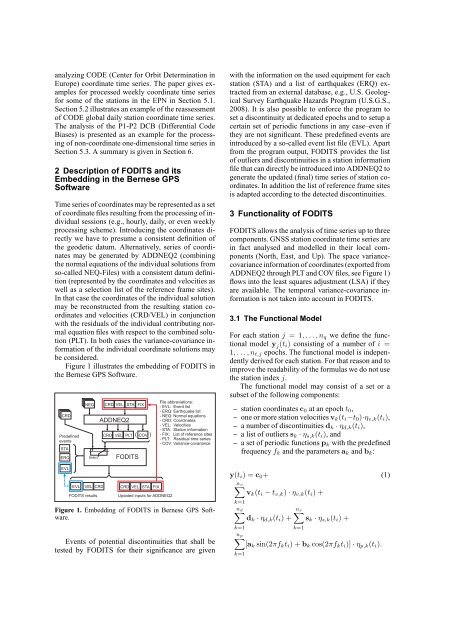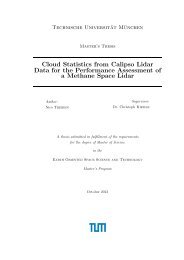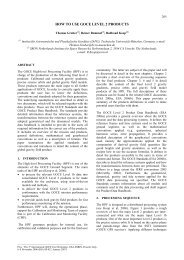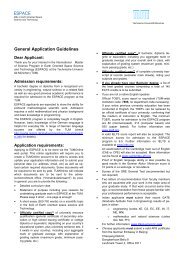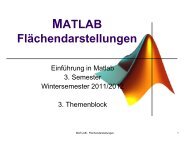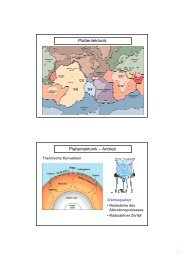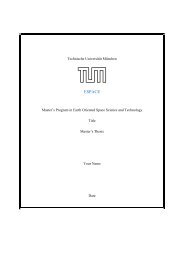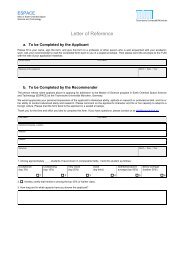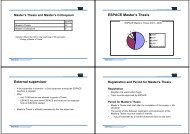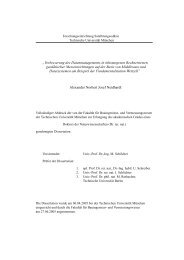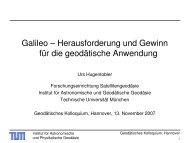FODITS - Institut für Astronomische und Physikalische Geodäsie ...
FODITS - Institut für Astronomische und Physikalische Geodäsie ...
FODITS - Institut für Astronomische und Physikalische Geodäsie ...
Create successful ePaper yourself
Turn your PDF publications into a flip-book with our unique Google optimized e-Paper software.
analyzing CODE (Center for Orbit Determination in<br />
Europe) coordinate time series. The paper gives examples<br />
for processed weekly coordinate time series<br />
for some of the stations in the EPN in Section 5.1.<br />
Section 5.2 illustrates an example of the reassessment<br />
of CODE global daily station coordinate time series.<br />
The analysis of the P1-P2 DCB (Differential Code<br />
Biases) is presented as an example for the processing<br />
of non-coordinate one-dimensional time series in<br />
Section 5.3. A summary is given in Section 6.<br />
2 Description of <strong>FODITS</strong> and its<br />
Embedding in the Bernese GPS<br />
Software<br />
Time series of coordinates may be represented as a set<br />
of coordinate files resulting from the processing of individual<br />
sessions (e.g., hourly, daily, or even weekly<br />
processing scheme). Introducing the coordinates directly<br />
we have to presume a consistent definition of<br />
the geodetic datum. Alternatively, series of coordinates<br />
may be generated by ADDNEQ2 (combining<br />
the normal equations of the individual solutions from<br />
so-called NEQ-Files) with a consistent datum definition<br />
(represented by the coordinates and velocities as<br />
well as a selection list of the reference frame sites).<br />
In that case the coordinates of the individual solution<br />
may be reconstructed from the resulting station coordinates<br />
and velocities (CRD/VEL) in conjunction<br />
with the residuals of the individual contributing normal<br />
equation files with respect to the combined solution<br />
(PLT). In both cases the variance-covariance information<br />
of the individual coordinate solutions may<br />
be considered.<br />
Figure 1 illustrates the embedding of <strong>FODITS</strong> in<br />
the Bernese GPS Software.<br />
CRD<br />
Predefined<br />
events<br />
STA<br />
ERQ<br />
EVL<br />
NEQ<br />
Select<br />
EVL VEL CRD<br />
<strong>FODITS</strong> results<br />
CRD VEL STA<br />
ADDNEQ2<br />
CRD VEL PLT<br />
<strong>FODITS</strong><br />
FIX<br />
( )<br />
COV<br />
CRD VEL STA FIX<br />
Updated inputs for ADDNEQ2<br />
File abbreviations:<br />
- EVL: Event list<br />
- ERQ: Earthquake list<br />
- NEQ: Normal equations<br />
- CRD: Coordinates<br />
- VEL: Velocities<br />
- STA: Station information<br />
- FIX: List of reference sites<br />
- PLT: Residual time series<br />
- COV: Variance-covariance<br />
Figure 1. Embedding of <strong>FODITS</strong> in Bernese GPS Software.<br />
Events of potential discontinuities that shall be<br />
tested by <strong>FODITS</strong> for their significance are given<br />
with the information on the used equipment for each<br />
station (STA) and a list of earthquakes (ERQ) extracted<br />
from an external database, e.g., U.S. Geological<br />
Survey Earthquake Hazards Program (U.S.G.S.,<br />
2008). It is also possible to enforce the program to<br />
set a discontinuity at dedicated epochs and to setup a<br />
certain set of periodic functions in any case–even if<br />
they are not significant. These predefined events are<br />
introduced by a so-called event list file (EVL). Apart<br />
from the program output, <strong>FODITS</strong> provides the list<br />
of outliers and discontinuities in a station information<br />
file that can directly be introduced into ADDNEQ2 to<br />
generate the updated (final) time series of station coordinates.<br />
In addition the list of reference frame sites<br />
is adapted according to the detected discontinuities.<br />
3 Functionality of <strong>FODITS</strong><br />
<strong>FODITS</strong> allows the analysis of time series up to three<br />
components. GNSS station coordinate time series are<br />
in fact analysed and modelled in their local components<br />
(North, East, and Up). The space variancecovariance<br />
information of coordinates (exported from<br />
ADDNEQ2 through PLT and COV files, see Figure 1)<br />
flows into the least squares adjustment (LSA) if they<br />
are available. The temporal variance-covariance information<br />
is not taken into account in <strong>FODITS</strong>.<br />
3.1 The Functional Model<br />
For each station j = 1, . . .,nq we define the functional<br />
model y j(ti) consisting of a number of i =<br />
1, . . .,nt,j epochs. The functional model is independently<br />
derived for each station. For that reason and to<br />
improve the readability of the formulas we do not use<br />
the station index j.<br />
The functional model may consist of a set or a<br />
subset of the following components:<br />
– station coordinates c0 at an epoch t0,<br />
– one or more station velocitiesvk(ti−t0)·ηv,k(ti),<br />
– a number of discontinuities dk · ηd,k(ti),<br />
– a list of outliers sk · ηs,k(ti), and<br />
– a set of periodic functions pk with the predefined<br />
frequency fk and the parameters ak and bk:<br />
y(ti) = c0+ (1)<br />
nv <br />
vk(ti − tv,k) · ηv,k(ti) +<br />
k=1<br />
nd<br />
ns<br />
<br />
dk · ηd,k(ti) + sk · ηs,k(ti) +<br />
k=1<br />
k=1<br />
np <br />
[ak sin(2πfkti) + bk cos(2πfkti)] · ηp,k(ti).<br />
k=1


